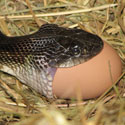
Rat snakes are often called chicken snakes because they hang around chicken coops. Their intent is to eat rats and mice, but after they’ve cleared out the rodents they look around for something else to eat. Bird eggs are often on a rat snake’s menu, and poultry eggs are no exception. Young poultry are also of interest.
By unhinging its jaw, a snake can eat things quite a bit bigger than its head. But sometimes a snake’s eyes are bigger than its stomach, so to speak. A partially grown dead chick with damp and matted feathers around its head and neck is likely the victim of a snake that was unable to get the meal down, and so spit it back out.
Identification
Rat snakes are non-aggressive, non-venomous, and popular as pets. They are also the most widespread North American snakes that regularly dine on poultry eggs and hatchlings. They may be found throughout the United States, appearing in more regionally variable colors and patterns than any other North American species. A rat snake may be all black or stunning shades of red, brown, yellow, or gray — plain, striped, or blotchy.
Identifying predation by a rat snake can be difficult, because the snake eats a chick or egg whole. Usually the only sign is one or more chicks or eggs missing. A snake can slither into a coop through a small opening, but after fattening up on chicks or eggs may not be able to slip back out the way it came in. Like many of us, a snake with a full belly typically wants to curl up for nap, and you may find one coiled in a nest or in a corner of the coop.
After the snake has slept off its meal and feels like traveling, it has little incentive to stick around an active poultry yard. It won’t be ready for another meal for at least 4 days, while digesting the recently eaten egg, chick, or rodent, and will move along on its own.
Exclusion
Excluding rat snakes from a coop can be a challenge. They can climb walls and squeeze through small openings. Covering windows and other openings with ¼-inch hardware cloth will keep snakes out at night, but not during the day when one could slither in through an open pophole. During the daytime, active poultry in the yard — guineas, turkeys, geese, and ducks (especially Muscovies — can discourage snakes, both because snakes avoid hustle and bustle and because poultry often attack and even eat snakes.
Remove hiding places around the coop, including piles of debris, wood, or rocks. Keep grass mowed. Collect eggs often, and don’t leave them in nests overnight. Check the coop for snakes before locking up at night. Make an effort to control rodents. Even though rat snakes will help you out in that department, they also use rodent tunnels to get inside the coop, so fill any open rodent tunnels you find.
Snake repellents work to varying degrees, from temporarily to not at all. Some require frequent application, may be toxic, or are so smelly they repel more humans than snakes. A snake trap works better, although you’ll need to check it often and release any captured snake, preferably no more than 200 yards from where it was trapped. That way the snake will still be within its home range, but will remember the bad experience of being trapped and not likely to return to that location.
Rat snakes are beneficial in controlling not only rats and other rodents, but also rat snakes eat venomous snakes, including rattlesnakes and copperheads. Unfortunately, some rat snake species are becoming rare and endangered, largely thanks to predation by humans. If a rat snake is getting into your coop, take measures to keep it out and leave the snake alone to do its job of protecting you and your poultry from objectionable rats and venomous snakes.
Gail Damerow, author, Storey’s Guide to Raising Chickens

